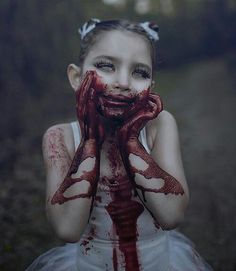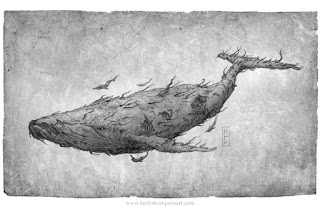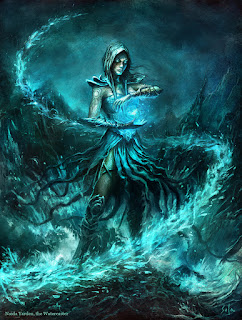A History of Death
Necromancers have been around for a very long time. Almost as long as death itself. They are older than humans, and older than most of the gods. The very first necromancers arose from a race long forgotten, back when words had real power. Back when death was knew, and even more frightening than it is today.
Once upon a time, a young child asked their mother to get up. They sobbed as dirt fell, covering her corpse until it was six feet underground.
But as I said, words had power. The mother's body heard her child, even if the soul had long since departed. She dug her way up before nature even knew what was wrong.
Thus began the necromancers. Kings eternal over kingdoms undying.
Wanderers
Nowadays, most necromancers are Wanderers. You do get the odd extra-antisocial manic who wants to live in a dungeon and conquer the lands of the living, but they don't last long. Sometimes they starve to death, or their focus lapses and their creations eat them. Anything can happen.
There are also sometimes pirates or priests, but they're a different thing altogether.
Wanderers, although despised, looked down on, and ridiculed by many, are an integral and valuable part of society. Like retail workers, if they could run an entire store with the corpses of your ancestors and sheer force of will.
Necromancers, in those places out of the eye of the True God, or simply willing to bend some rules, provide labour, defence, or even entertainment, for a fee. Many of the more selfless ones even forgo the cost, doing good deeds for free.
The typical life of a Wanderer follows a simple pattern: Get to town with a group of undead, reanimate as many more as possible, work for a few weeks, get kicked out, repeat.
Of course, they often move on simply because the pay wasn't good, or because they got bored, but mages are notorious drama queens.
All schools of wizardry have a negative emotion that they suffer increasing amounts of, simply from casting their spells. Necromancers are lonely. They have the power at their fingertips to raise armies, bring the dead (partially) back, and turn enemies into friends, but they are lonely.
It's an ironic hell that they live in.
Most small towns were built by Wanderers, or at least started by them. When settlers came, the Wanderers paved the way. They built the first houses in the mountains, and gave the order to drag their own limp, dehydrated bodies across deserts to found sugar plantations.
Wanderers have a strained relationship with the Church of the True God. The Church's inclination to kill all necromancers other than themselves is conflicted with their desire to make life better for themselves and, to a lesser extent, their followers.
With the common folk, Wanderers are treated as an unpleasant necessity. Some towns are more welcoming than others, but the general respond to a Wanderer is 'here's some cash, do the job, and get out.'
Necromancers and ghouls generally fight, as both of them view corpses as a precious commodity. Both of them together, however, will often make a great team.
Necromancy. What is it?
Now: Necromancy is defined as:
Necromancy (/ˈnɛkrəˌmænsi, -roʊ-/[1][2]) is a supposed practice of magic involving communication with the deceased – either by summoning their spirit as an apparition or raising them bodily – for the purpose of divination, imparting the means to foretell future events or discover hidden knowledge, to bring someone back from the dead, or to use the deceased as a weapon, as the term may sometimes be used in a more general sense to refer to black magic or witchcraft.[3][4]
Now, for today, we're focusing on the 'Bodily part. The core of what a necromancer does. Turning a useless old sack of meat and stink into a helpful old sack of meat and stink. Sometimes this is slow, sometimes this is fast. Sometimes you need to call up the spirit of a fallen warrior to posses the body, sometimes you just need to tell the muscles that to do. It all depends.
In addition, the types of undead are exceedingly varied. You've got your typical zombies, skeletons, crawling claws... but then you have odder things. Skin kites, nailmen, organ-snakes... the list goes on. A sufficiently experienced necromancer should be able to make four or five functional undead from a single body.
Necromancy, at it's heart, is a complicated process. Everyone approaches it differently, and listing all the different methods possible is too large a project for this post.
Necromancy, at it's heart, is a complicated process. Everyone approaches it differently, and listing all the different methods possible is too large a project for this post.
The City of the Dead
The City of the Dead is not quite a city. It's a library. Countless rooms, towers, and basements, each filled to the brim with books. It was made over the course of nearly a thousand years, and tended to by an army of undead. Although anyone is allowed to peruse it's endless halls, necromancers are the most frequent patrons.
It is guarded by the same army that cleans it, organizes the shelves, and carries candles for any mortal who wishes to read. The entire place is protected by wards, preventing fires, water, or removal of books.
Mages, the curious, and any who would add to the library's defences or knowledge are welcomed with open arms. No one owns the library, and nobody knows who originally created it, but it protects itself. It has endured the rise and fall of many empires, and catalogued them all.
Some mages have made their homes there, nestled in the crooks and crannies of shelves, seeking out the secrets of immortality, death, and ultimate power within the books. They are most often necromancers, as they can send their servants to fetch food and drink from the outside world.
Ghosts often frequent the halls, often simply to read, wiling away their afterlife on the pursuit of knowledge.
It is guarded by the same army that cleans it, organizes the shelves, and carries candles for any mortal who wishes to read. The entire place is protected by wards, preventing fires, water, or removal of books.
Mages, the curious, and any who would add to the library's defences or knowledge are welcomed with open arms. No one owns the library, and nobody knows who originally created it, but it protects itself. It has endured the rise and fall of many empires, and catalogued them all.
Some mages have made their homes there, nestled in the crooks and crannies of shelves, seeking out the secrets of immortality, death, and ultimate power within the books. They are most often necromancers, as they can send their servants to fetch food and drink from the outside world.
Ghosts often frequent the halls, often simply to read, wiling away their afterlife on the pursuit of knowledge.





















